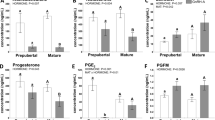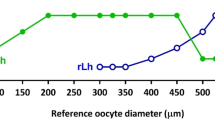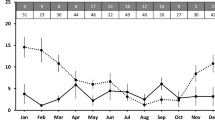Abstract
OVULATION in Xenopus laevis can be induced by injecting human chorionic gonadotrophin (HCG); this procedure has been used to diagnose pregnancy1,2, or for the biological assay of HCG. Either the proportion of animals ovulating in a group, or the number of eggs laid by each individual, may form the basis of a test3–5. A dose of 90 international units (IU) of HCG causes ovulation in most Xenopus, although there is a considerable variation in the number of eggs laid by each individual, from a few tens to several thousands. A method to estimate the number of eggs laid is described here.
This is a preview of subscription content, access via your institution
Access options
Subscribe to this journal
Receive 51 print issues and online access
$199.00 per year
only $3.90 per issue
Buy this article
- Purchase on Springer Link
- Instant access to full article PDF
Prices may be subject to local taxes which are calculated during checkout
Similar content being viewed by others
References
Bellerby, C. W., Nature, 133, 494 (1934).
Shapiro, H. A., and Zwarenstein, H., Nature, 133, 762 (1934).
Landgrebe, F. W., Proc. Roy. Soc. Edin., B, 63, 213 (1948).
Hobson, B. M., J. Obst. Gyn. Brit. Emp., 59, 352 (1952).
Bastian, J. W., thesis, Purdue Univ. (1954).
Di Vita, G., and Barr, W. A., Intern. J. Rad. Biol., 6, 485 (1963).
Author information
Authors and Affiliations
Rights and permissions
About this article
Cite this article
BARR, W., HOBSON, B. & DI VITA, G. Method for estimating the Number of Eggs laid by Xenopus laevis in Response to the Injection of Gonadotrophin. Nature 214, 827–828 (1967). https://doi.org/10.1038/214827a0
Issue Date:
DOI: https://doi.org/10.1038/214827a0
This article is cited by
-
Optimisation of an oviposition protocol employing human chorionic and pregnant mare serum gonadotropins in the Barred Frog Mixophyes fasciolatus (Myobatrachidae)
Reproductive Biology and Endocrinology (2012)
-
Induction of ovulation in Xenopuswithout hCG injection: the effect of adding steroids into the aquatic environment
Reproductive Biology and Endocrinology (2011)
Comments
By submitting a comment you agree to abide by our Terms and Community Guidelines. If you find something abusive or that does not comply with our terms or guidelines please flag it as inappropriate.



